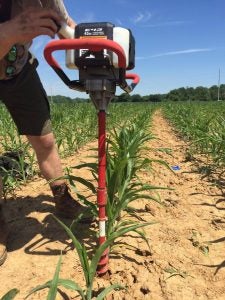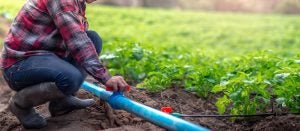A majority of farmers and ranchers agree that water conservation is a worthy goal. But as water conservation technology advances, many consider its associated costs and balk at updating irrigation equipment and water management practices.
Cost is a concern, and not just the expense of buying and implementing the technology. Real and perceived costs also include the time and frustration of learning new technologies and adapting to new ways of doing things, especially when established methods produce adequate yields.
Agriculture also has lagged behind in fully embracing new water-management technology because the cost of water use in commercial agriculture is usually relatively cheap compared with other inputs and expenses.

Perhaps they’re already engaging in decades-old water conservation practices, but some of these methods — such as conventional automatic irrigation systems — might be headed for obsolescence. That’s because automation alone is not enough. Research suggests that “water-conserving” irrigation systems that aren’t Internet-connected and software-managed can help individual enterprises with efficiencies and earnings, but actually result in more water use overall as farmers parlay these gains to expand operations.
Next-gen technologies transforming agriculture
Ready or not, new and innovative technologies are poised to transform agriculture. With water scarcity worsening as a global concern, “smart ag” technologies are considered a key component of water conservation.
Applying next-generation technology to water conservation is urgently needed in agriculture. Agricultural operations annually account for about 70 percent of global freshwater use, according to the World Bank. That amounts to two quadrillion gallons of water, an incomprehensible number, so let’s break it down to size.
Cattle raised for beef each drink up to 30 gallons of water daily, while dairy cattle each quaff up to 50 gallons. These volumes hardly represent the livestock’s total water footprint. In the case of a ranching operations in drought-prone areas, the livestock’s drinking water is but a fractional amount of the total used; the overall footprint includes irrigation for grazing.
» Related: The importance of water as a factor in livestock production
Alongside other “smart ag” innovations, the application of Internet of Things (IoT) — the concept of connecting physical objects to the Internet and other devices for the purpose of capturing and sharing data — in agriculture arose in response to water scarcity, as well as in anticipation of other challenges to come. These devices generally are:
- Internet-connected
- Sensor-monitored
- Data-reporting
- Software-managed
- Remote-controlled
Data-driven decisions key to effective water management practices
As the smart agriculture revolution enters its next phase, data will emerge as a driving force in water management. Indeed, where smart ag technology like IoT implementation has taken place, the continual collecting and processing of data guides day-to-day water management decisions, resulting in demonstrable water conservation while maintaining the health and worth of livestock and crops.
In that sense, this technology plays a critical role in agriculture’s future. By adding a mix of wireless data-monitoring technology (Wi-Fi, Bluetooth, cellular, or satellite) to existing “things,” including water tanks, pumps, and troughs, ag operations can be made more efficient, resulting in lower labor costs and increased yields.

If data is the driving force, connectivity is the octane, and where Wi-Fi and cellular coverage is lacking, edge computing processes data at or near the source, enabling farmers and ranchers to respond quickly to changing conditions or problems detected by smart sensors and transmitted via satellite.
» Related: Why the Land O’Lakes-led broadband initiative is so vital to America
These tech applications and benefits extend beyond water conservation. These advances also help people and the planet and enrich the future of the ag industry by attracting younger, tech-savvy workers to farming and rural areas.
High-level research on IoT-driven water management is nascent but auspicious, and the growing body of enterprise-level data and case studies, not to mention the potential consequences of continued inaction, bolsters the case for proactive as opposed to reactive adoption.
Make no mistake — various forces are pressing farmers to increase yields with less water, and if push comes to shove, regulators will seek to curb usage with access rights or other obstacles. Farmers don’t want to be caught off-guard by water-use constraints, legislative or otherwise. Therefore, they should do what their forebears have done for eons: plan, nurture, and grow using the most advanced tools and technologies available.
Jeff Horton is the Chief Revenue Officer of FreeWave Technologies, a Colorado-based company that aims to help equip agricultural operations with real-time data insights and control.



